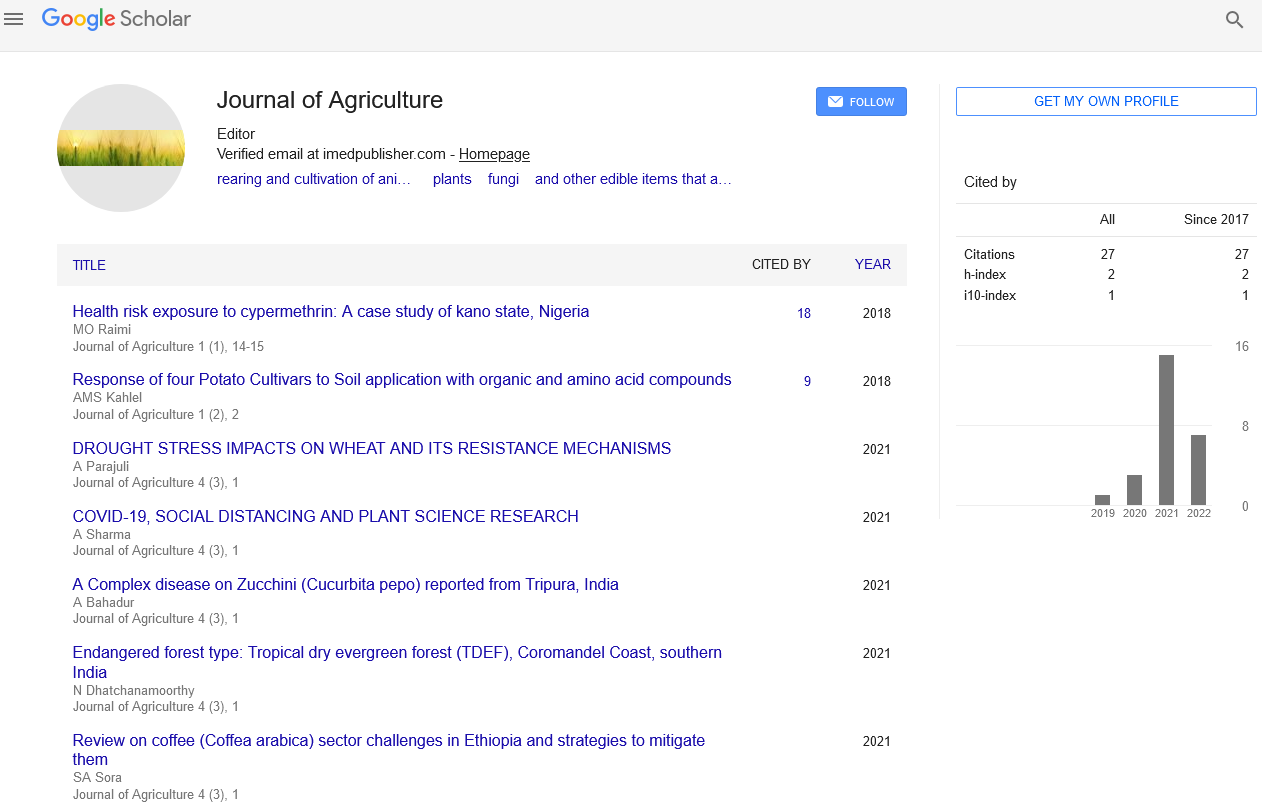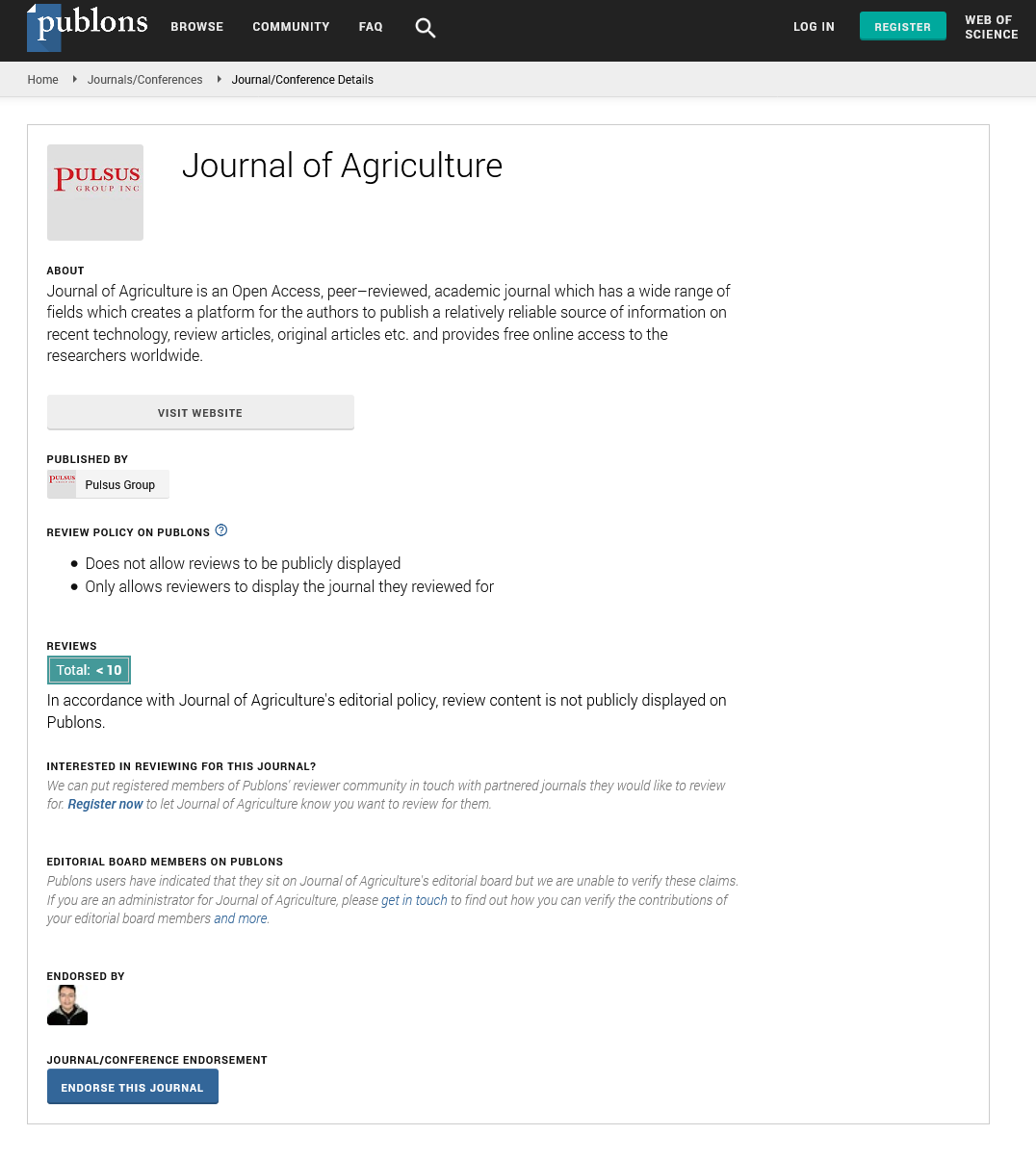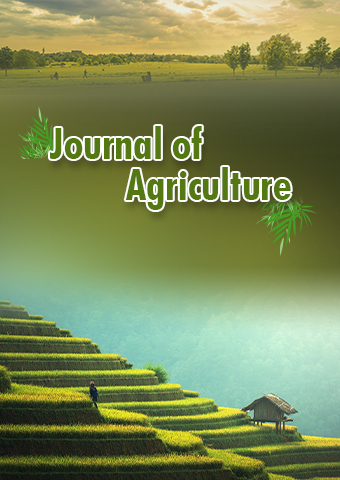Editorial - Journal of Agriculture (2023) Volume 6, Issue 4
The Application of Pesticides: Balancing Agricultural Needs and Environmental Concerns
Ashwani K Gupta*
College of Mechanical and Electronic Engineering, Nanjing Forestry University, Jiangsu, China
College of Mechanical and Electronic Engineering, Nanjing Forestry University, Jiangsu, China
E-mail: Kashwanik54@gmail.com
Received: 01-Aug-2023, Manuscript No. jagri-23-108486; Editor assigned: 03-Aug-2023, Pre-QC No. jagri-23-108486 (PQ); Reviewed: 17- Aug-2023, QC No. jagri-23-108486; Revised: 22-Aug-2023, Manuscript No. jagri-23-108486 (R); Published: 29-Aug-2023; DOI: 10.37532/ jagri.2023.6(4).100-102
Abstract
Pesticides play a crucial role in modern agriculture by protecting crops from pests, diseases, and weeds, thereby ensuring food security and increasing agricultural productivity. However, their application raises environmental, health, and ethical concerns, necessitating a balanced approach to maximize benefits while minimizing adverse impacts. This abstract provides an overview of the application of pesticides, highlighting the challenges faced, the benefits obtained, and the importance of adopting sustainable practices for a more responsible and resilient agricultural future.
Keywords
Pesticides • Agricultural productivity
Introduction
Pesticides play a significant role in modern agriculture by controlling pests, diseases, and weeds, thereby ensuring crop yields and food security. However, their widespread application has raised concerns about environmental impact, human health risks, and the development of pesticideresistant pests. This article explores the application of pesticides, their benefits, challenges, and the efforts made to strike a balance between agricultural needs and environmental preservation [1,2].
The role of pesticides in agriculture
Pesticides encompass a diverse range of chemicals designed to protect crops and livestock from harmful organisms. They are primarily used for pest management, including insects, fungi, bacteria, viruses, and unwanted plants (weeds). By controlling these pests, pesticides contribute to increased agricultural productivity and help ensure a stable and abundant food supply.
Types of pesticides
Pesticides are categorized based on the type of pest they target and the chemical composition. The major types include insecticides, herbicides, fungicides, rodenticides, and bactericides. Each type is tailored to address specific pest challenges faced by farmers [3].
Benefits of pesticide application
Increased crop yields: Pesticides protect crops from pests and diseases, minimizing yield losses and maximizing agricultural productivity.
Food security: By safeguarding crops, pesticides contribute to stable food production, reducing the risk of food shortages and price fluctuations [4].
Economic benefits: Pesticides protect farmers’ investments by ensuring higher yields, improving profitability, and supporting rural economies.
Disease control: Pesticides play a vital role in controlling vector-borne diseases, such as malaria and dengue, by targeting disease-carrying insects [5].
Challenges and concerns
Environmental impact: The widespread use of pesticides can lead to contamination of soil, water bodies, and air, adversely affecting nontarget organisms and ecosystems [6].
Pesticide resistance: Frequent and improper pesticide application can lead to the development of resistance in pests, rendering certain chemicals less effective over time .
Human health risks: Pesticides can pose health hazards to farmers, farmworkers, and consumers if not used correctly or with inadequate safety measures.
Non-target effects: Pesticides may harm beneficial insects, birds, and animals, disrupting ecological balance and biodiversity [7].
Persistence and accumulation: Some pesticides can remain in the environment for extended periods, leading to bioaccumulation in the food chain.
Mitigating environmental impact
Integrated pest management (IPM): IPM is a holistic approach that combines various pest control methods, such as crop rotation, biological controls, and selective pesticide use, to minimize environmental impact [8].
Pesticide formulation and application techniques: Innovations in pesticide formulation and application technologies can reduce drift, limit off-target exposure, and optimize effectiveness.
Education and training: Providing farmers and pesticide applicators with proper training on pesticide use and safety measures can mitigate risks and improve application practices [9].
Regulation and monitoring: Governments and international organizations play a crucial role in setting standards, monitoring pesticide use, and enforcing regulations to ensure responsible application.
Discussion
The application of pesticides in agriculture presents a double-edged sword, as it provides numerous benefits while posing serious challenges to the environment, human health, and sustainable agriculture. Adopting integrated and innovative pest management strategies, alongside promoting sustainable agricultural practices, will pave the way towards a more resilient and ecologically responsible future. Balancing the need for pest control with the preservation of ecosystems is essential to achieve a harmonious coexistence between agriculture and the environment [10].
Conclusion
The application of pesticides has undeniably revolutionized agriculture and contributed to feeding the world’s growing population. However, their widespread use has raised environmental and health concerns. To ensure sustainable agriculture, it is essential to strike a balance between the benefits of pesticide application and the preservation of our ecosystems. Implementing integrated pest management practices, fostering innovation, and promoting responsible pesticide use are crucial steps towards achieving this delicate balance. By prioritizing environmental stewardship, human health, and long-term sustainability, we can optimize the benefits of pesticide application while minimizing its adverse effects.
References
- Reverter M, Sarter S, Caruso D et al. Aquaculture at the crossroads of global warming and antimicrobial resistance. NatCommun.11(1), 1870-1879 (2020).
- Nesar A, Thompson S, Giovanni M. Organic aquaculture productivity, environmental sustainability, and food security: insights from organic agriculture.Food Security.12, 1253-1267 (2020).
- Kiran P, Adi J. Aquaculture role in global food security with nutritional value: a review.TranslAnimSci. 3(2), 903-910 (2019).
- Ogello EO, Mlingi FT, Nyonje BM et al. Can integrated livestock-fish culture be a solution to East Afircan's food insecurity? A Review.African J Food Agric Nutr Dev.13 (4), 8058-8078 (2013).
- Shah J, Ali A. Combined effect of Bacillus fortis IAGS 223 and zinc oxide nanoparticles to alleviate cadmium phytotoxicity in Cucumis melo. Plant PhysiolBiochem. 158, 1-12(2021).
- Schwartz SE, Levine RA, Weinstock RS et al. Sustained pectin ingestion: effect on gastric emptying and glucose tolerance in non-insulin-dependent diabetic patients. Am J Clin Nutr. 48, 1413-7 (1988).
- Anderson JW, Ward K. High-carbohydrate, high-fiber diets for insulin-treated men with diabetes mellitus. Am J Clin Nutr. 32, 2312-21 (1979).
- Zhao J, Li M, Gu D et al. Involvement of rice histone deacetylase HDA705 in seed germination and in response to ABA and abiotic stresses.Biochemical and Biophysical Research Communications.470, 439-444(2016).
- Liu X, Luo M, ZhangW et al. Histone acetyltransferases in rice (Oryza sativaL.): phylogenetic analysis, subcellular localization and expression.BMC plant biology.12,1-17 (2012).
- Anderson JW, Ward K. High-carbohydrate, high-fiber diets for insulin-treated men with diabetes mellitus. Am J Clin Nutr. 32, 2312-21 (1979).
Indexed at, Google Scholar, Crossref
Indexed at, Google Scholar, Crossref
Indexed at, Google Scholar, Crossref
Indexed at, Google Scholar, Crossref
Indexed at, Google scholar, Crossref
Indexed at, Google scholar, Crossref
Indexed at, Google Scholar, Crossref
Indexed at, Google Scholar, Crossref


